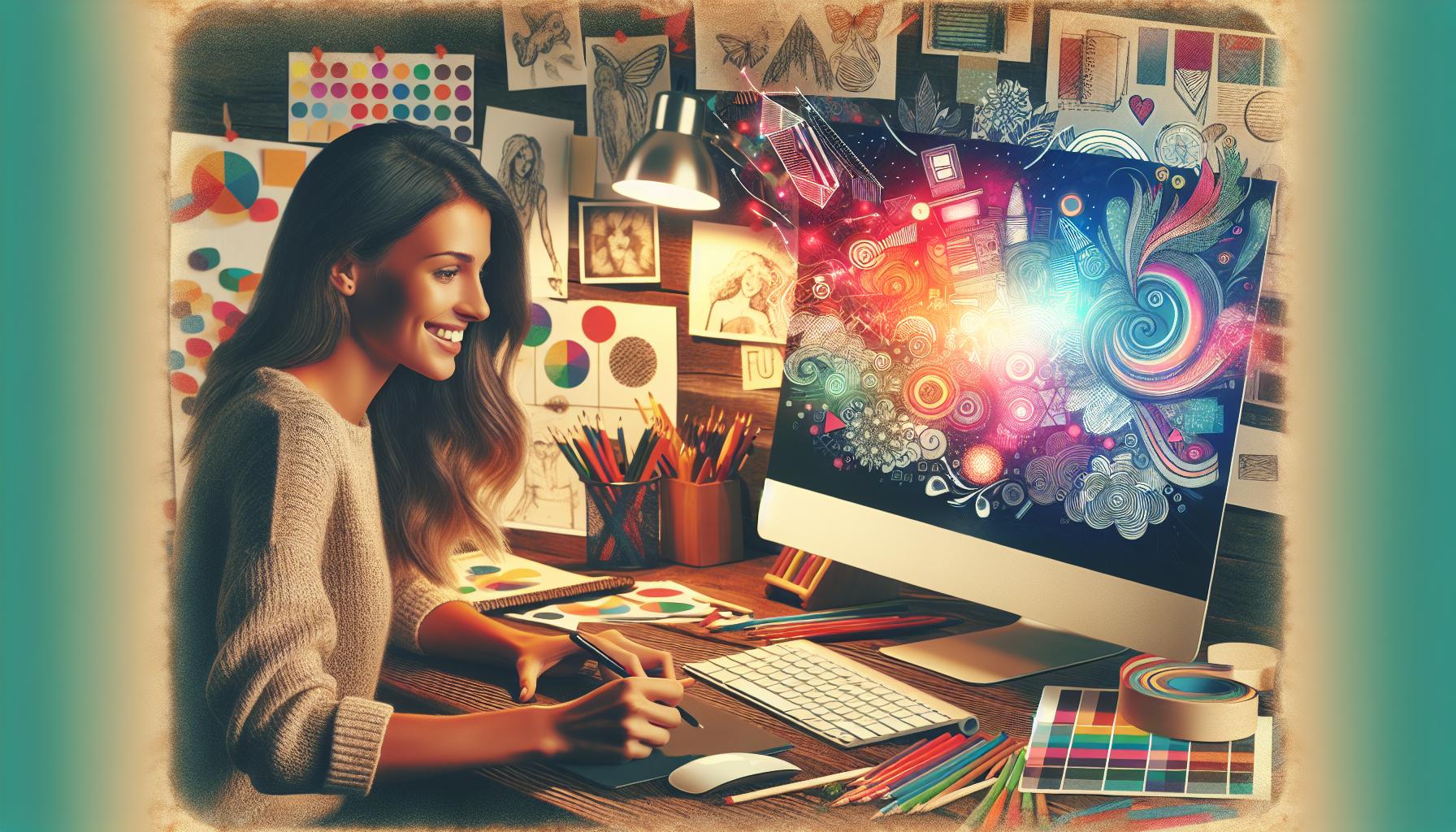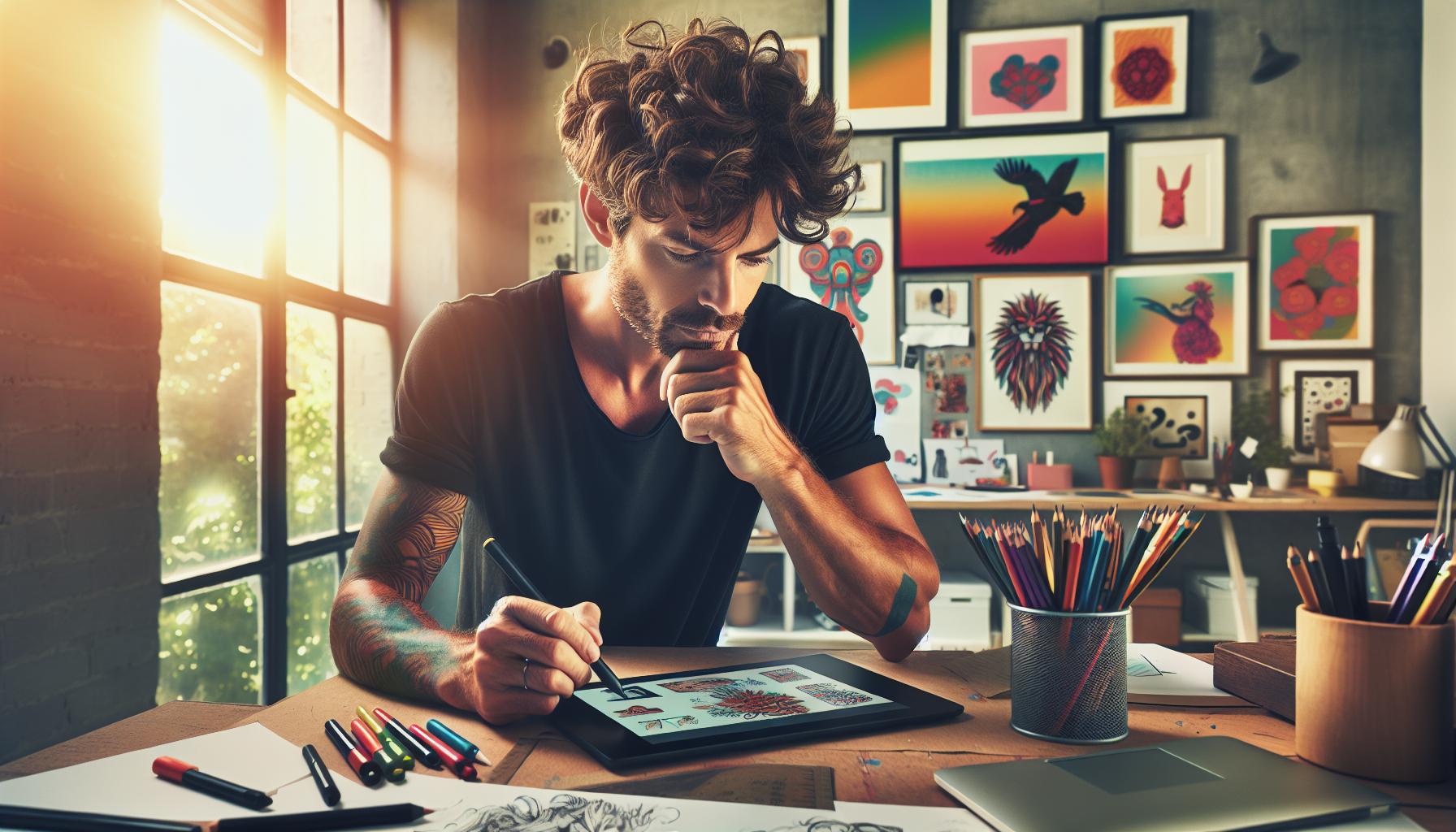Effective graphic design is more than just aesthetics; it’s a powerful tool that communicates messages and shapes perceptions. Understanding the key elements that make up successful design can elevate a brand’s identity and engage audiences in meaningful ways. This article explores those essential components, revealing why mastering them is crucial for anyone looking to make an impact in the visual landscape.
Key Takeaways
- Key Elements of Design: Effective graphic design comprises balance, contrast, alignment, repetition, white space, typography, colour, and imagery, all of which contribute to impactful communication.
- Importance of Visual Communication: Graphic design simplifies complex information, facilitating quicker understanding and emotional connection with the audience.
- Brand Identity Reinforcement: Consistent use of visual elements helps establish a strong brand identity, fostering customer loyalty and recognition.
- Typography Mastery: Choosing appropriate fonts and setting up text effectively greatly influences readability and the overall tone of the design.
- Effective Use of Space: White space enhances clarity and focus, while a well-considered layout ensures a smooth flow of information.
- Leveraging Tools and Resources: Access to graphic design software and online resources boosts productivity and creativity, enabling designers to create high-quality visuals.
What Are the Key Elements of Effective Graphic Design?
Effective graphic design consists of several essential elements that contribute to clear communication and brand recognition. Understanding these elements helps designers create impactful visuals.
Balance
Balance refers to the distribution of visual weight in a design. Designers employ symmetrical or asymmetrical balance to create harmony throughout the layout. Symmetrical designs convey professionalism, while asymmetrical ones can create visual interest and dynamism.
Contrast
Contrast enhances readability by differentiating between elements. By using opposing colours, shapes, or sizes, designers can make specific components stand out. High contrast improves legibility, guiding the viewer’s eye to important information.
Alignment
Alignment ensures every element in a design relates to others, creating a cohesive appearance. Proper alignment leads to a cleaner layout, helping viewers navigate the content easily. Consistency in alignment strengthens overall design integrity.
Repetition
Repetition reinforces brand identity and creates visual consistency. By repeating colours, fonts, shapes, or patterns, designers create a unified and recognisable look. This technique helps establish a familiar aesthetic across different platforms.
White Space
White space, or negative space, plays a crucial role in design. It prevents clutter and allows for breathing room around elements. This technique enhances comprehension, making designs appear more elegant and professional.
Typography
Typography involves selecting fonts that align with the brand’s message. Font choice affects readability and emotional impact. Designers consider font size, style, and spacing when creating text-based designs to ensure clarity and engagement.
Colour
Colour influences emotions and perceptions. Effective use of colour can evoke feelings and set a mood. Designers select a colour scheme that not only aligns with the brand identity but also appeals to the target audience.
Imagery
Imagery includes photographs, illustrations, and icons that support the overall message. High-quality images enhance visual storytelling, making content more engaging and relatable. The relevance of imagery to the brand message is vital for effective communication.
By mastering these key elements, designers create effective graphic designs that communicate messages clearly and leave a lasting impression.
Importance of Graphic Design

Effective graphic design plays a vital role in communication and engagement. It’s not just about aesthetics; it conveys messages, shapes perceptions, and enhances user experiences.
Visual Communication
Visual communication relies on graphics to express ideas quickly and efficiently. It uses images, colours, and typography to create a message that resonates with the audience. Effective visuals simplify complex information, making it more accessible. Infographics, for example, present data in an engaging format that aids understanding. A well-designed visual can evoke emotional responses, guiding viewer interpretation and influencing decisions.
Brand Identity
Graphic design is essential in establishing and maintaining brand identity. Consistent use of visual elements like logos, colours, and typography builds recognition and trust. A strong brand identity differentiates a business from competitors. Effective graphic design reinforces this identity, creating a cohesive image across various platforms. This consistency fosters familiarity and loyalty among customers, leading to a more robust market presence.
Key Elements of Graphic Design
Understanding the key elements of graphic design is essential for creating effective visuals that communicate messages clearly. Each component contributes significantly to the overall design, ensuring coherence and functionality.
Line and Form
Lines and forms establish the visual structure of a design. Lines guide the viewer’s eye and create pathways through the layout. They can be straight, curved, or angular, influencing the overall mood. Forms, defined by enclosed lines, add depth and dimension. For example, geometric shapes provide a modern feel, while organic forms offer a more natural aesthetic. Designers use these elements to convey emotions and organise content effectively.
Colour Theory
Colour theory involves understanding how colours interact and the psychological effects they have on viewers. Warm colours, like red and orange, evoke energy and passion, while cool colours, such as blue and green, promote calmness and trust. Colour schemes can be complementary, analogous, or monochromatic. For instance, a complementary colour scheme uses opposing colours to create striking contrast, enhancing readability and visual interest. Knowledge of colour theory allows designers to select colours that align with brand identity and desired emotional responses.
Typography
Typography refers to the style and appearance of text in a design. Selecting appropriate typefaces affects readability and conveys tone. Serif fonts often suggest tradition and reliability, while sans-serif fonts appear modern and clean. Hierarchy, established through font size and weight, guides the viewer in navigating content. For example, headings should stand out with larger, bolder fonts, while body text remains easy to read. Mastery of typography enhances communication and strengthens brand recognition.
Space and Layout
Space, or white space, is the area that surrounds design elements. Effective use of space prevents clutter, allowing for better focus on key components. Layout determines how these elements are arranged, contributing to the overall flow of information. A balanced layout leads the viewer’s eye and facilitates comprehension. For example, a grid layout provides structure and consistency, while an asymmetrical layout creates dynamic tension. Designers must consider both space and layout to ensure clarity and visual appeal.
Consistency
Consistency in graphic design reinforces brand identity and message. Maintaining uniformity across visual elements, such as fonts, colours, and styles, builds recognition and trust. Consistent designs create a cohesive look and feel, making materials instantly identifiable. For instance, companies often use a defined brand style guide to ensure consistency across all platforms. This practice strengthens brand presence and connects with the audience effectively.
Tools and Resources for Graphic Designers
Effective graphic design requires access to a range of tools and resources that facilitate the creative process. These tools enhance productivity, streamline workflows, and improve the overall quality of designs.
Software Options
Graphic designers frequently rely on software applications tailored for specific design tasks. Common options include:
- Adobe Creative Cloud: This suite includes Photoshop for image editing, Illustrator for vector graphics, and InDesign for layout design, among others. Each application excels in its field, providing comprehensive features for professionals.
- CorelDRAW: Known for its vector graphic capabilities, CorelDRAW offers tools for creating unique illustrations and designs, making it popular among graphic designers.
- Affinity Designer: This software provides an alternative to Adobe products, offering robust features for vector and raster design without subscription fees.
- Canva: Ideal for non-designers, Canva simplifies the design process with pre-made templates and easy-to-use tools. It’s suitable for social media graphics, presentations, and posters.
- Sketch: Primarily used for web and app design, Sketch offers usability for creating and collaborating on interface designs.
Online Resources
Numerous online resources support graphic designers in various aspects of their work. Key resources include:
- Tutorial Platforms: Websites like Lynda.com and Udemy provide courses on graphic design skills, covering topics from basics to advanced techniques.
- Stock Asset Libraries: Services like Adobe Stock, Shutterstock, and Unsplash offer extensive libraries of images, illustrations, and graphics for use in designs.
- Design Communities: Platforms like Behance and Dribbble allow designers to showcase their work, gain feedback, and find inspiration from others within the creative community.
- Fonts and Typography Resources: Websites such as Google Fonts and DaFont provide access to a wide range of typefaces, enhancing typographic choices in design projects.
- Colour Palettes: Tools like Adobe Colour and Coolors help designers create and explore colour palettes, facilitating better colour scheme selections.
Accessing these tools and resources equips graphic designers with the skills and elements necessary to produce high-quality, effective designs that communicate messages clearly and effectively.
Conclusion
Effective graphic design is integral to successful communication and brand identity. By mastering the key elements such as balance, contrast, and typography, designers can create visuals that not only attract attention but also convey messages clearly. The strategic use of colour and imagery enhances emotional connections with audiences, making information more accessible and engaging.
With the right tools and resources, designers can refine their skills and produce high-quality work that resonates with viewers. Ultimately, investing in effective graphic design strengthens a brand’s presence in the market and fosters lasting relationships with customers.
Frequently Asked Questions
What is the main purpose of graphic design?
Graphic design serves as a powerful means of communication that goes beyond aesthetics. Its main purpose is to convey ideas effectively, influence perceptions, and enhance user experiences through well-structured visuals.
Why are the key elements of graphic design important?
Understanding the key elements of graphic design, such as balance, contrast, and colour, is crucial as they help create impactful visuals. These elements enhance a brand’s identity and engage audiences, ensuring clarity and effective communication.
How do visuals influence perceptions?
Visuals influence perceptions by quickly conveying information and evoking emotional responses. Effective graphic design can guide viewer interpretation, making complex data more accessible and impacting decision-making.
What role does graphic design play in brand identity?
Graphic design establishes and maintains brand identity by consistently using visual elements like logos and colours. This consistency builds recognition, trust, and loyalty among customers, differentiating the brand from competitors.
What are some essential tools for graphic designers?
Essential tools for graphic designers include software like Adobe Creative Cloud, CorelDRAW, and Canva. Additionally, online resources such as design communities, tutorial platforms, and stock asset libraries support the creative process and enhance design quality.
How does colour theory impact graphic design?
Colour theory impacts graphic design by determining how colours interact and their psychological effects. Proper use of colour enhances readability, aligns with brand identity, and can significantly influence viewers’ emotional responses and perceptions.
Why is typography important in graphic design?
Typography is vital in graphic design as it conveys tone and hierarchy. The selection of typefaces affects readability and can enhance the overall message, influencing how viewers perceive the content.
What does effective layout ensure in design?
An effective layout ensures clarity and prevents clutter in graphic design. It organises visual elements thoughtfully, allowing the viewer to navigate content easily, which improves overall communication and user experience.
